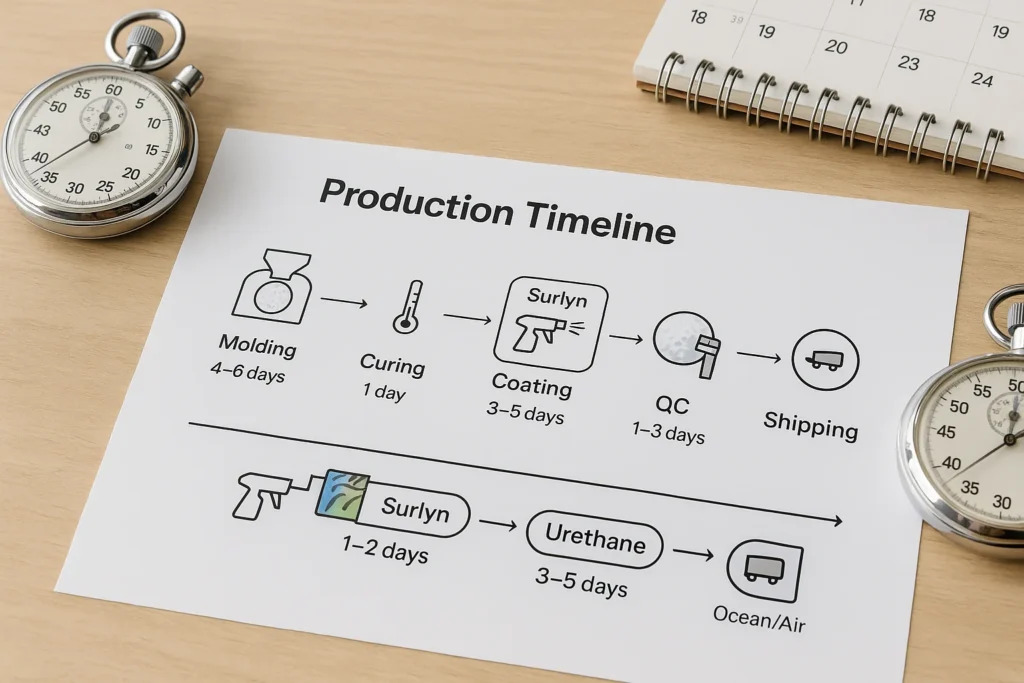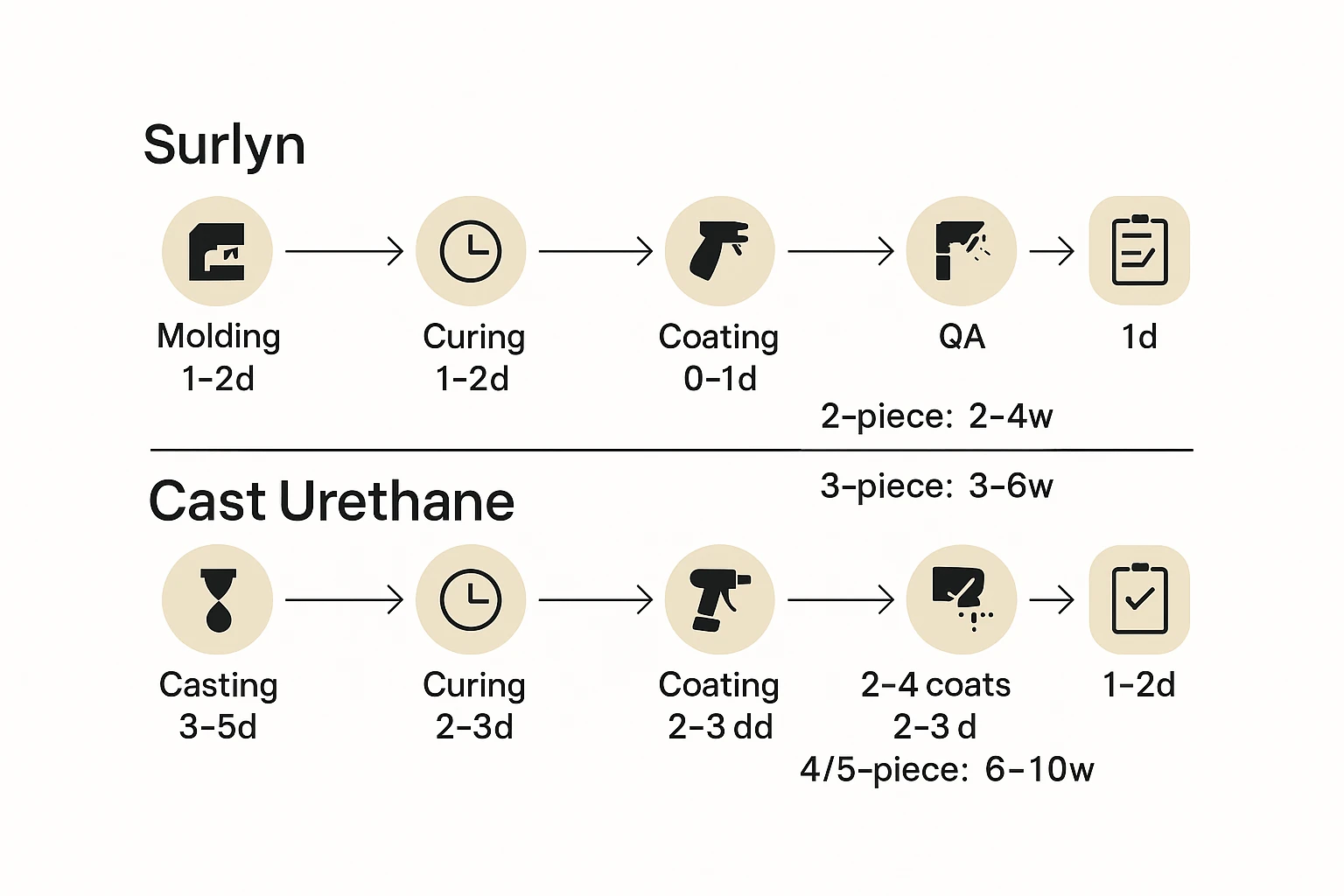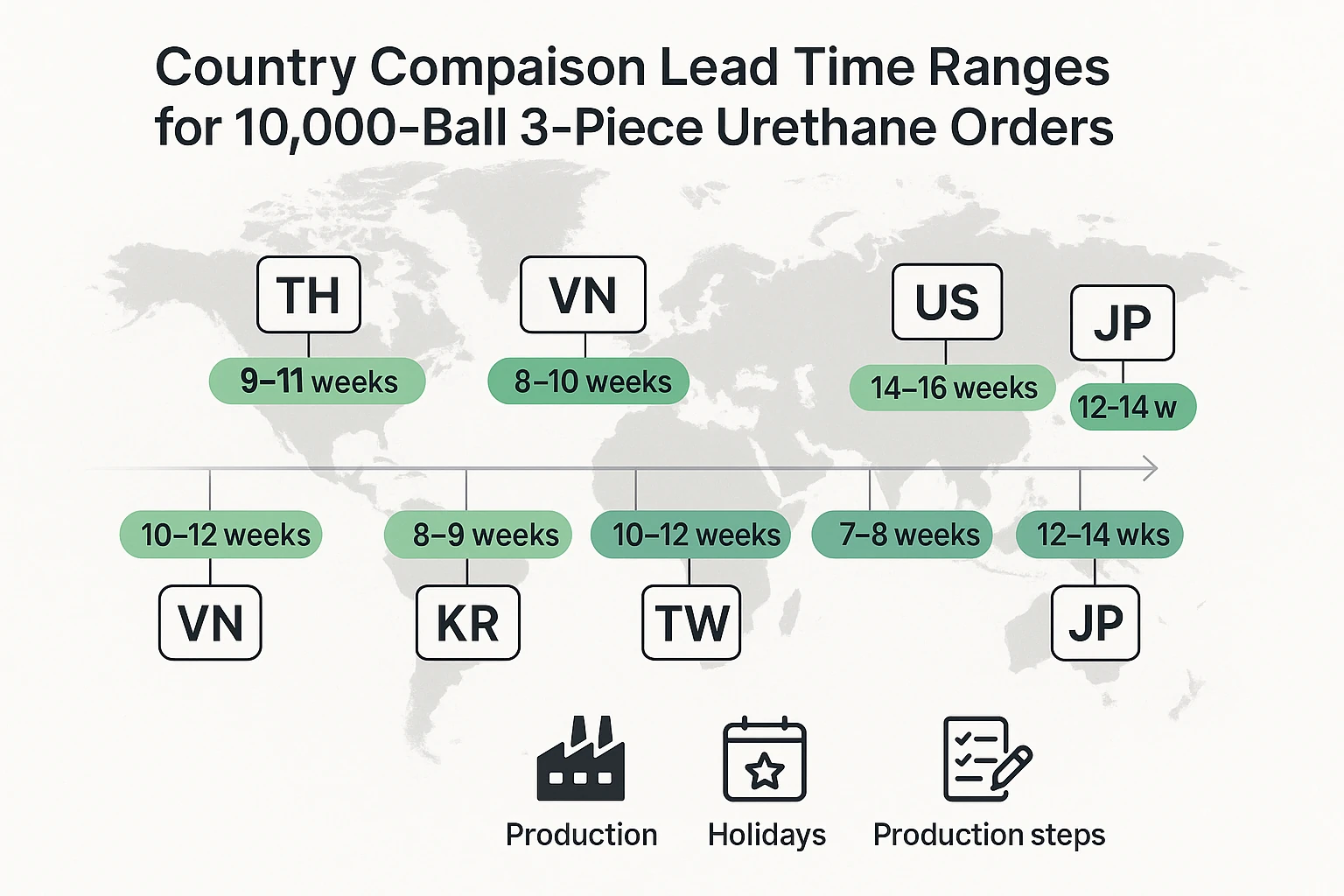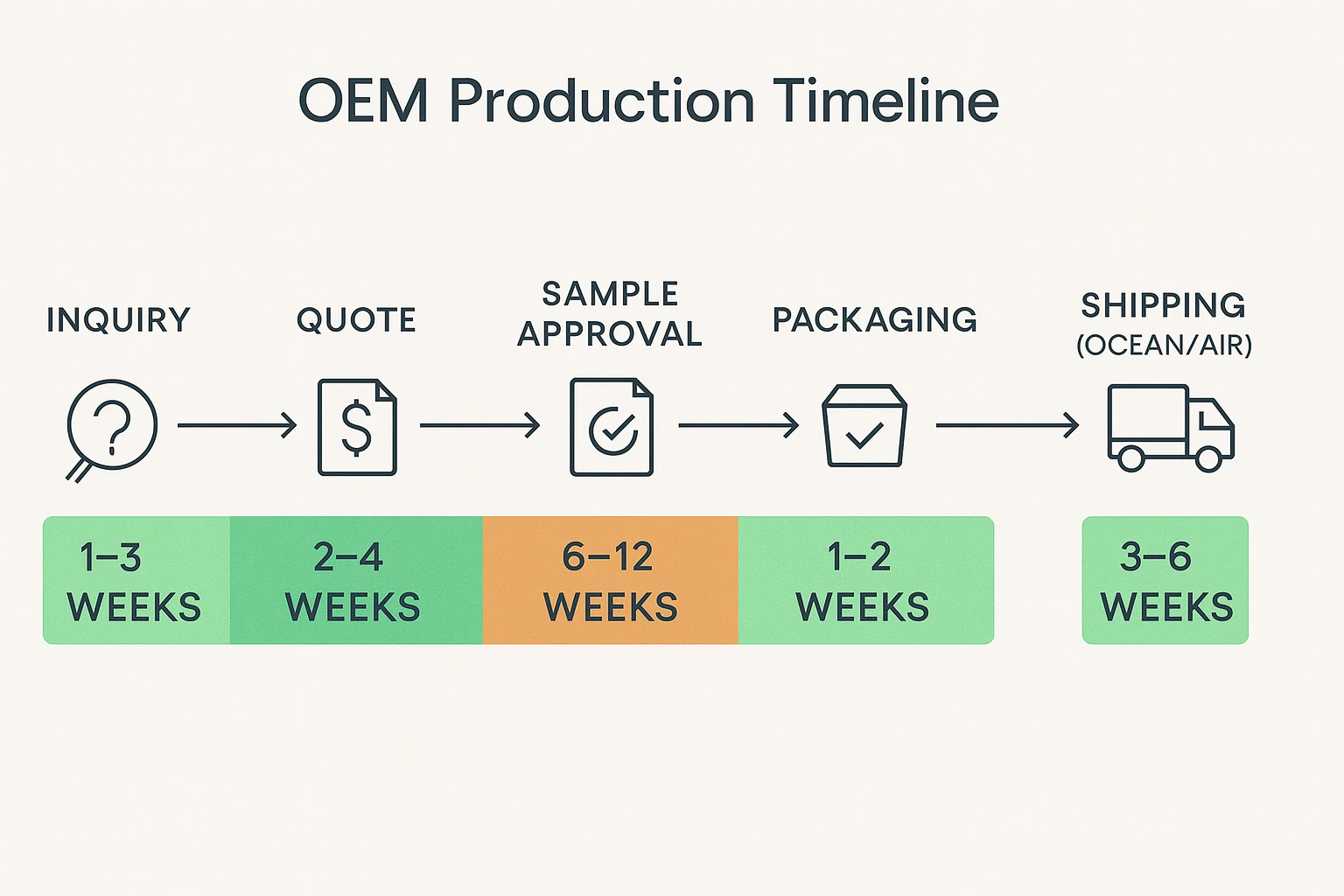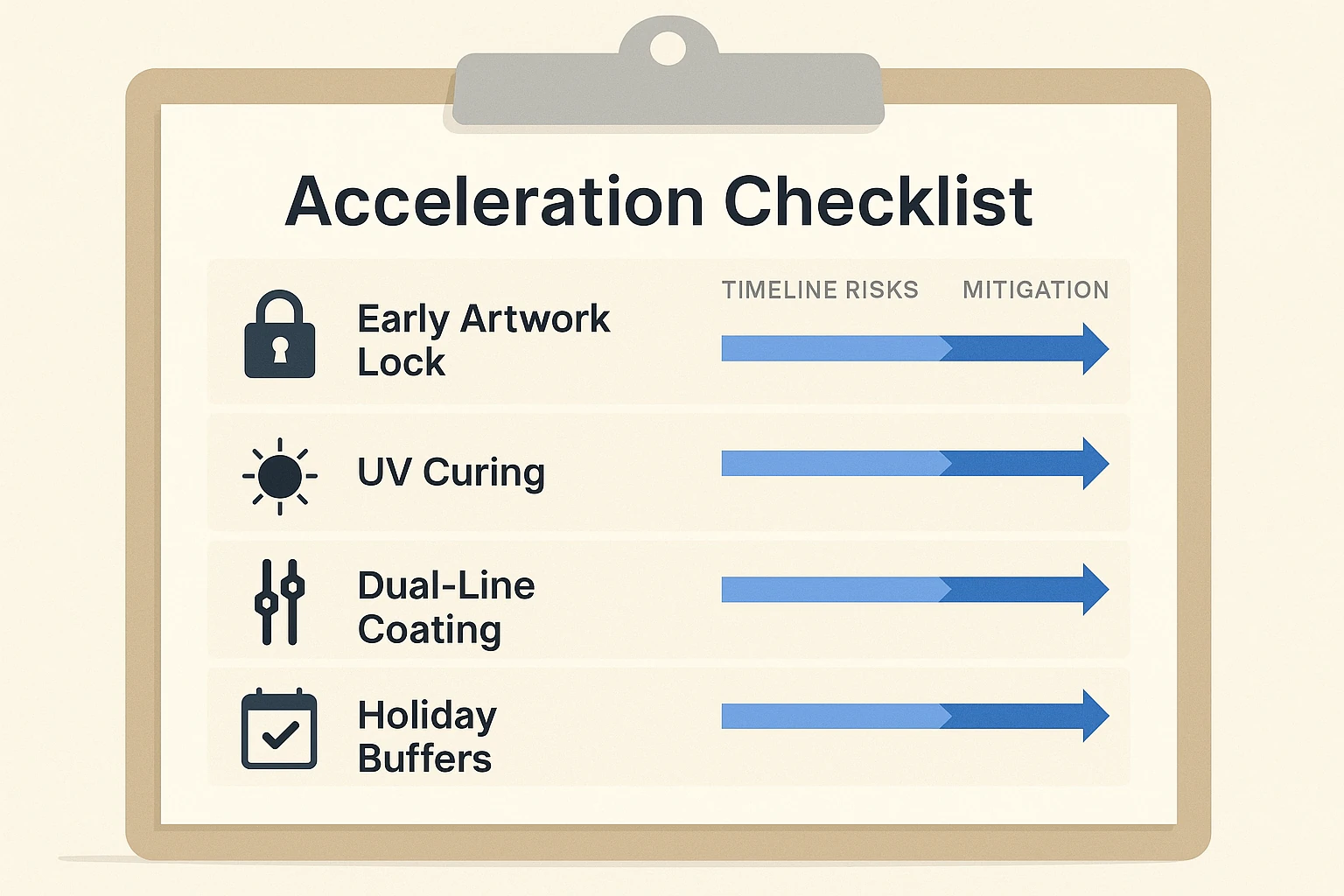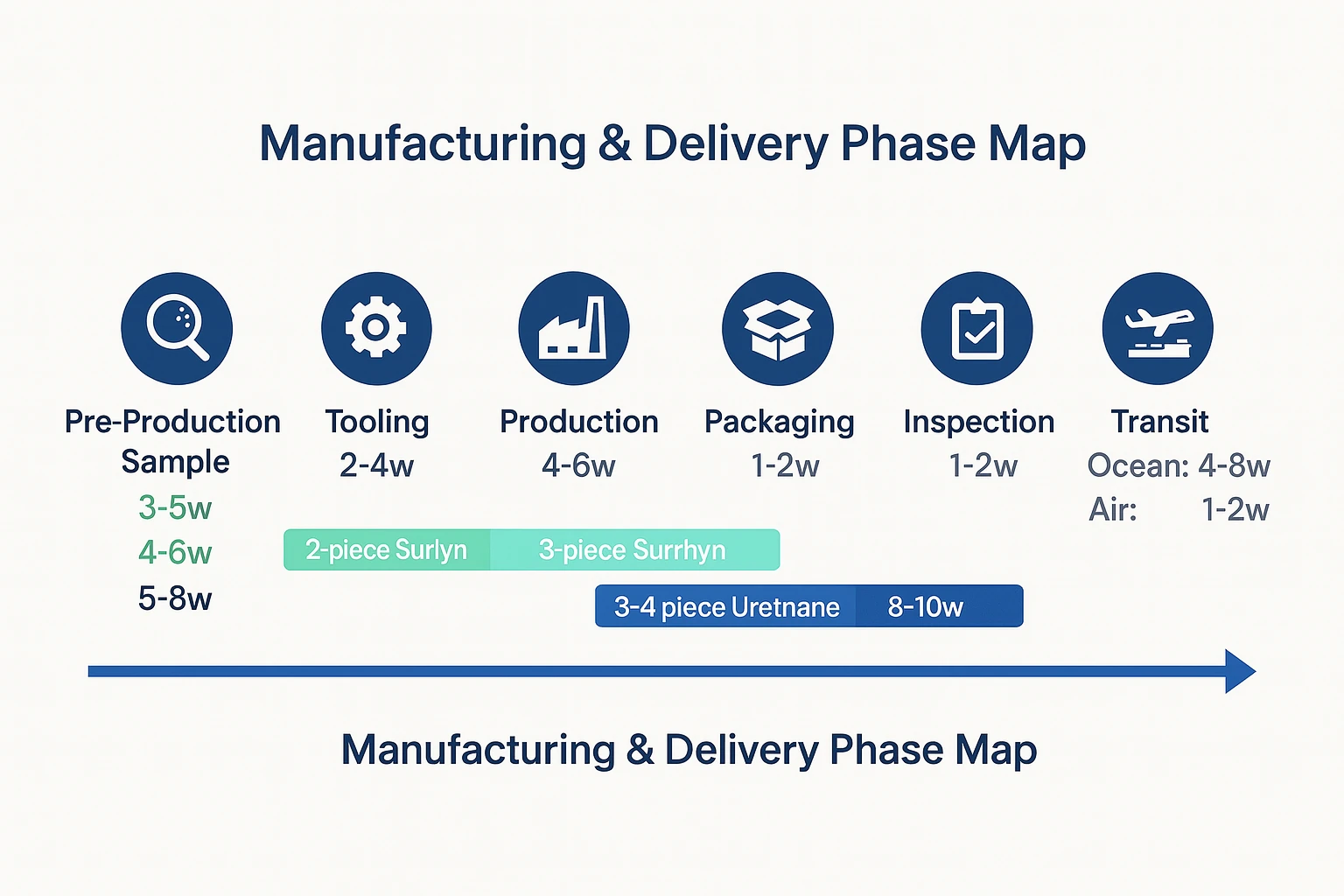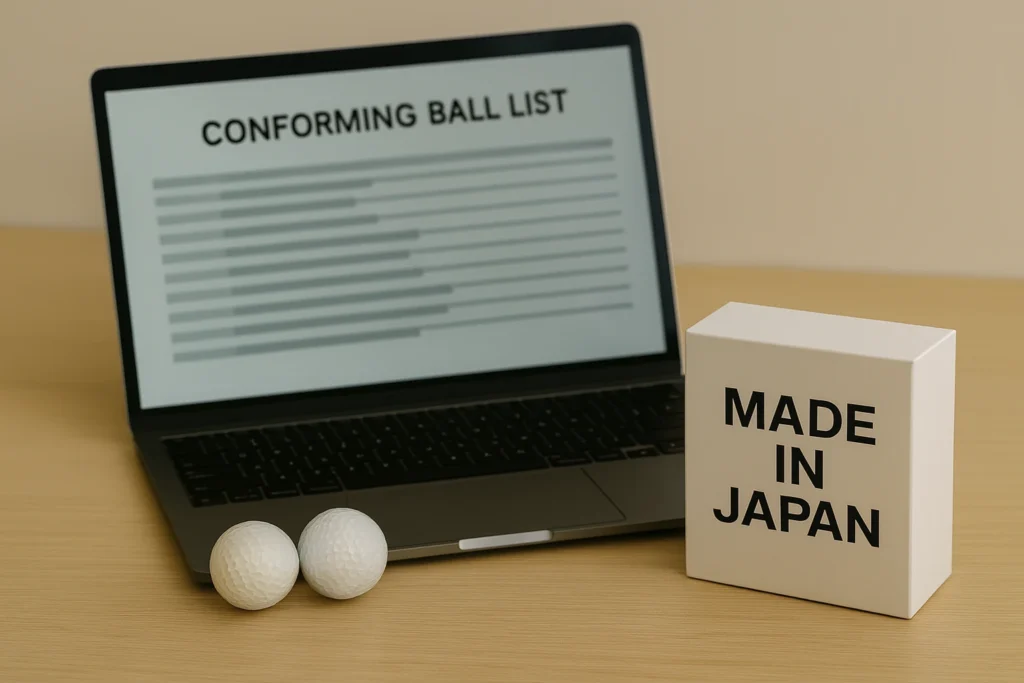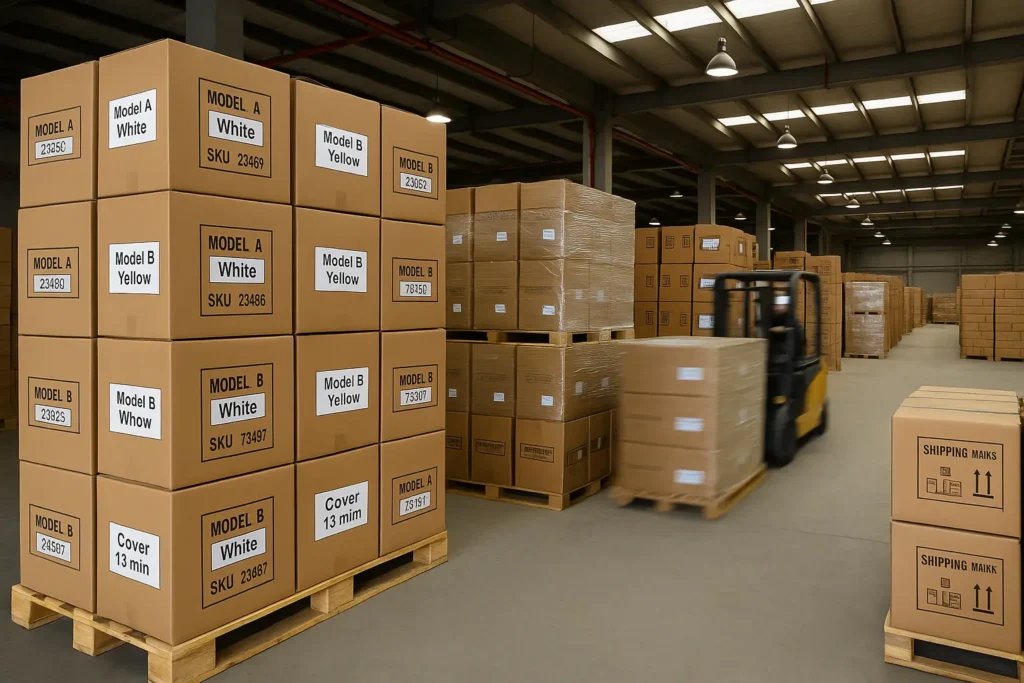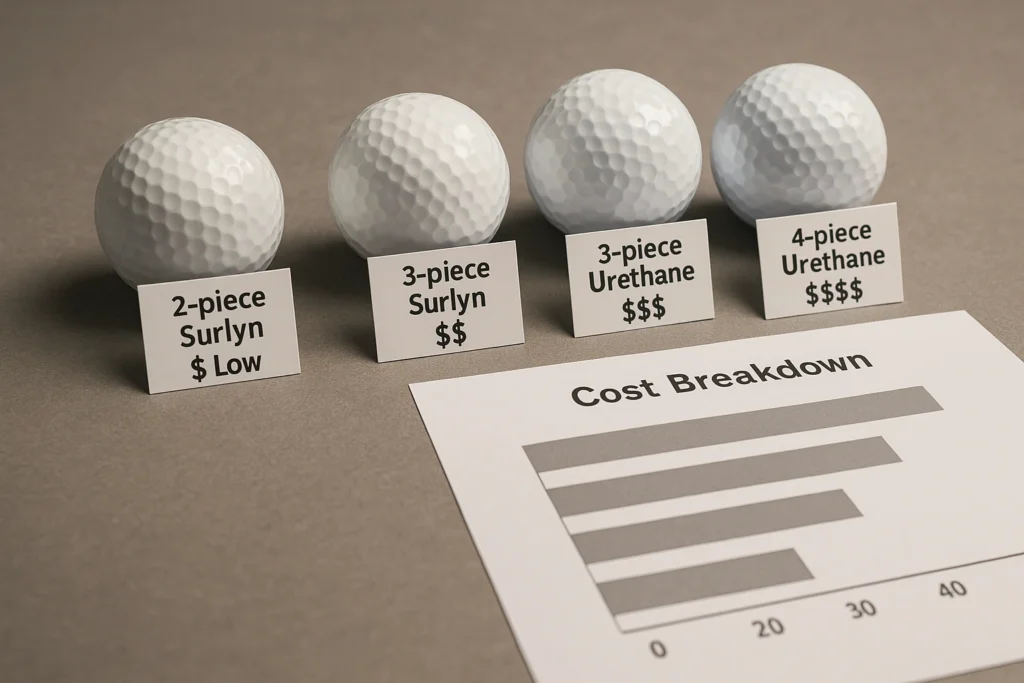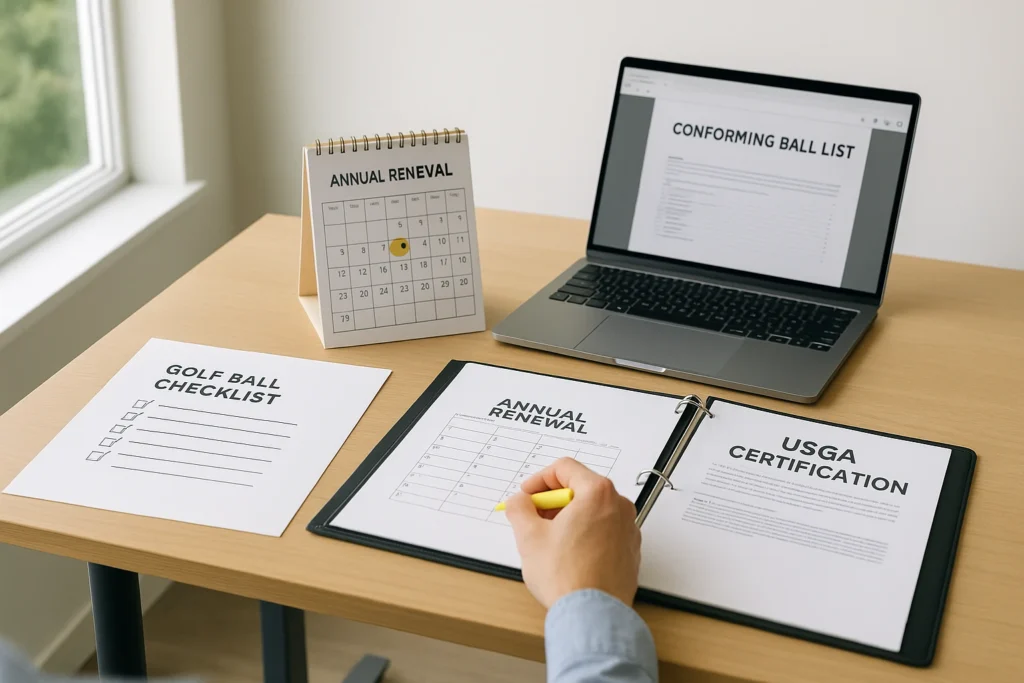A two-piece Surlyn golf ball typically requires 2–5 processing days, while three- or four-piece cast urethane needs 5–12. Most OEM orders run 3–8 weeks ex-factory, plus 2–5 weeks by ocean (or 3–7 days by air). Lock specs early and run packaging in parallel for predictable timelines.
China OEM lead times (ex-factory, after pre-production sample approval): 2-piece Surlyn 15–25 days; 3-piece 18–30; 4-piece cast urethane 30–50+; 5-piece 40–60+. Packaging 8–20 days (parallel). Transit: ocean CN→US 20–40 days (EU 30–40); air 5–10. Order ahead: 60–90 days (ocean) or 35–55 (air).
Recent Western clients have asked for rush deliveries. We understand the urgency, but many “urgent” OEM orders are inherently hard because a full project includes sampling, tooling, production, packaging, inspection, and logistics—especially during peak season. You may face the same situation. This article gives you a clear timeline to plan procurement and avoid last-minute orders. In B2B, on-time delivery is everything.
Q1. What actually determines how long golf balls take to make?
Manufacturing time is set by five levers: construction, materials, factory maturity, packaging scope/parallelization, and shipping/seasonality.
Construction: do more layers always mean longer time?
More layers add molding/casting passes and QC gates, so cycle time usually grows with layers; thin-shell builds also raise rework risk. A 2-piece Surlyn flows fast; a 4- or 5-piece cast urethane adds mantles, casting, post-cure, and tighter tolerances.
Layer count determines station count. Each station creates a queue and an inspection. Thin shells (0.45–0.65 mm) demand tighter roundness/concentricity, so repairs stretch the calendar. Plan buffers around casting, grinding, and coating when layers exceed three.
Materials: why is Surlyn faster than cast urethane?
Surlyn is thermoplastic injection—parts eject in seconds; cast urethane is a reactive system that needs gel time, post-cure, and gentler finishing, so lines run slower by design.
Surlyn covers de-mold hot and move quickly to tumble and coat. Cast urethane requires controlled reaction, oven dwell, then measured trimming to preserve greenside bite. That chemistry-driven tempo defines “golf ball production time” for Tour-type balls.
Factory maturity & OEE: how do stable lines change lead time?
Mature lines standardize thin-U recipes and stabilize yield, removing rework loops and schedule churn; ramp-up lines add uncertainty and buffers.
Where cast-urethane lines are seasoned, day-to-day takt is stable. Newer lines show hour-to-hour output variance, so planners add days. Watch coating ovens, casting cells, and final QC—they are the usual bottlenecks.
Packaging & logistics: can they block the critical path?
Packaging lead time is 3–10 working days and should run in parallel; shipping mode adds days to weeks after ex-factory, especially across peak seasons and holidays.
Lock dielines and Pantone by Day 3–5. For logistics, ocean adds 2–5 weeks; air 3–7 days plus clearance. Port congestion and holidays can shift your answer to “how long to make a golf ball” by weeks.
Table — Variables vs. Typical Impact
| Variable | Typical impact on time |
|---|---|
| Layers / construction | ↑ layers → ↑ steps/QC → longer cycle |
| Material system | Surlyn faster; cast urethane needs post-cure |
| Factory maturity & OEE | Stable lines reduce rework/waiting |
| Packaging scope | Gift boxes/inserts add 3–10 working days |
| Shipping mode & seasonality | Ocean +2–5 weeks; peak seasons add buffer |
Bottom line: every lever ultimately shifts calendar days—control them early to control “how long it takes to manufacture golf balls.”
Q2. How long does it take by construction and material?
Two-piece Surlyn needs about 2–5 processing days; multi-layer cast urethane needs 5–12, with order-level lead time extended by materials, tooling, proofs, and queues.
2–3-piece Surlyn: what is the realistic calendar?
Expect a 2–3-week lead time for repeat models, because materials, proofs, scheduling, QC, and packing stack around a 2–5-day processing core; new tooling or fixtures can add another 1–3 weeks.
Surlyn shells inject fast and coat fast. But commercial confirmation, plate making, and packaging supply define the calendar. Merge white/yellow runs to save changeover. UV top-coat and dual lines often shave 0.5–1 day.
3–4-piece cast urethane: why is it slower?
Cast urethane adds gel and post-cure windows, gentler grind/trim, and stricter roundness and shell thickness controls; repeat models ship in 3–5 weeks, while new models with validation need 5–8 weeks.
Thin-U (0.45–0.65 mm) boosts spin control but narrows process windows. Using dual-point COR acceptance (e.g., 38 m/s and 43 m/s) prevents rework spirals that burn days.
Note: tables list working days; “weeks” are calendar (ex-factory) weeks including weekends).
Table — Phase-by-Phase Processing Time (working days)
| Phase | 2–3-piece Surlyn | 3–4-piece cast urethane |
|---|---|---|
| Raw materials on hand/replenish | 3–10 | 5–15 |
| New mold/fixture (if required) | 7–21 | 10–30 |
| Color/logo proofing & samples | 3–7 | 5–10 |
| Line scheduling & production | 3–7 | 7–14 |
| QC/aging/re-test | 1–3 | 2–5 |
| Packing materials/boxing/dispatch | 1–3 | 1–3 |
| Typical order lead time | 2–3 weeks | 3–5 weeks |
| New model w/ validation | 3–5 weeks | 5–8 weeks |
✔ True — Why cast urethane takes longer than Surlyn
Cast urethane is a reactive, cross-linking system that needs gel and post-cure time; Surlyn is thermoplastic injection with second-scale ejection. Thin-U shells demand tighter concentricity/roundness and gentler surface finishing to preserve greenside spin—raising rework risk and stretching takt.
✘ False — “Same steps, just different resin”
Treating urethane like Surlyn ignores curing kinetics and finishing constraints. It leads to unrealistic schedules and quality compromises.
Q3. For the same 10,000-ball 3-piece urethane order, how do timelines differ by country?
For the same 10k 3-piece urethane order, mature TH/VN/TW/KR lines ship in 3–5 weeks, CN in 4–6 (5–8 ramp-up), and US/JP in 6–10.
Pure processing times: where do days actually go?
Casting/post-cure and coating cells set the takt; Thailand/Vietnam/Taiwan/Korea run 7–12 processing days, China 10–15 on stable lines, and U.S./Japan about 8–14 depending on scheduling.
These are “no-queue” durations. Real lead time layers on packaging supply and line access.
Table — Pure Processing Time (working days)
| Process step | TH/VN/KR/TW | CN (stable U line) | US/JP |
|---|---|---|---|
| Core compounding/vulcanize/aging | 2–3 | 2–3 | 2–4 |
| Mantle forming (over-mold/encase) | 1–2 | 1–3 | 1–2 |
| Urethane casting + post-cure | 3–6 | 4–8 | 3–6 |
| Deburr/grind/trim | 1–2 | 1–3 | 1–2 |
| Coating (primer/top) + ovens | 2–3 | 2–4 | 2–3 |
| Pad/transfer print | 0.5–1 | 0.5–1.5 | 0.5–1 |
| Final QC (dia/weight/compression) | 0.5–1 | 0.5–1.5 | 0.5–1 |
| Subtotal (pure processing) | 7–12 | 10–15 | 8–14 |
Packaging lead time: can it be faster in China?
Standard OEM packaging adds 3–10 working days; in China’s dense printing ecosystem it often runs 5–10, TH/VN/KR/TW 7–12, and US/JP 8–15—run it in parallel so it never blocks the ball-making path.
Lock dielines, Pantone, and barcodes by Day 3–5 after PO and ask for digital proofs first.
Table — Packaging Lead Time (parallel run)
| Packaging step | TH/VN/KR/TW | CN (PRD/East China) | US/JP |
|---|---|---|---|
| Artwork/die-line confirmation | 1–2 | 1–2 | 1–3 |
| Digital sample (carton/sleeves) | 2–3 | 1–2 | 2–4 |
| Mass printing + lamination/UV | 4–7 | 3–6 | 5–8 |
| Insert/EVA/blister (if any) | 4–7 | 3–6 | 5–8 |
| Materials to plant + assembly | 1–2 | 1–2 | 1–3 |
| Subtotal (packaging supply) | 7–12 | 5–10 | 8–15 |
Composite ex-factory lead time: what’s the spread?
Repeat models: TH/VN 3–4 weeks, KR/TW 3–5, CN 4–6, US/JP 6–8. New with sampling: add ~1–2 weeks. Peaks/holidays push to the conservative ranges shown below.
Include Songkran/rainy season, Tet, Chuseok/LNY, and China National Day.
Table — Holiday Buffers by Country
| Country/Region | Holidays (examples) | Typical impact (days) | Note |
|---|---|---|---|
| Thailand | Songkran, rainy season | 3–7 | Casting queues extend; transit slows |
| Vietnam | Tet (Lunar New Year) | 3–7 | FDI plants re-slot after the break |
| Korea | Chuseok, Lunar New Year | 3–6 | Tight capacity amplifies slips |
| Taiwan | Lunar New Year | 2–5 | Tooling/QC cadence often the limiter |
| China | National Day, Lunar New Year | 3–9 | Thin-U yield + logistics congestion |
| Japan | Golden Week, Obon | 3–7 | Local packaging/approval cadence |
| US/EU | Thanksgiving/Xmas, August EU | 2–6 | Local scheduling + customs windows |
Table — Composite Lead Time (ex-factory)
| Country/Region | Repeat model | New w/ sampling | Peak/holidays (conservative) | Typical bottleneck |
|---|---|---|---|---|
| Thailand | 3–4 weeks | 4–6 weeks | 5–7 weeks | Casting queue; Songkran/rainy |
| Vietnam | 3–4 weeks | 4–6 weeks | 5–7 weeks | FDI scheduling; Tet |
| Korea | 3–5 weeks | 5–7 weeks | 6–8 weeks | Tight capacity; Chuseok/LNY |
| Taiwan | 3–5 weeks | 5–7 weeks | 6–8 weeks | Tooling & QC cadence |
| China (thin-U) | 4–6 weeks | 5–8 weeks | 6–9 weeks | Thin-U yield; National Day/LNY |
| US/Japan | 6–8 weeks | 8–10 weeks | 10–12 weeks | Local scheduling; compliance/pack |
✔ True — Same spec doesn’t guarantee same timeline
Factories interpret thin-U specs differently due to chemistry, tooling, and QC cadence. The same parameters can yield different takt and rework, so country-to-country lead times legitimately diverge even when the BOM matches.
✘ False — “If the spec matches, time must match too”
Assuming spec = time ignores bottlenecks at casting/coating and holiday calendars. Execution—and parallelization—sets the calendar.
Same spec, different calendars: chemistry windows, bottleneck cells, and holiday buffers—not brochures—determine how long it takes to manufacture golf balls across countries.
Q4. How much time does OEM packaging add?
Standard OEM packaging adds 3–10 working days; run it in parallel so it never blocks the critical path.
Standard vs. premium: what’s the delta?
White dozens and simple sleeves run in 1–2 days once plates are ready; printed color boxes, lamination/UV, and inserts add material handling and QC, pushing 5–10 days.
Digital proofs accelerate decisions. Co-locate packaging supply near the plant to avoid transit lag.
Table — Packaging Types vs. Time
| Packaging type | Typical time (working days) |
|---|---|
| White inner boxes / dozens | 1–2 |
| Printed color gift boxes | 5–10 |
| Mesh/fabric bags | 3–5 |
| Blister + printed card | 4–6 |
How do we prevent packaging from becoming the blocker?
Freeze dielines/Pantone by Day 3–5, approve digital proofs in 24–48 h, and run inserts/EVA/blister in parallel with ball finishing; these steps keep packaging off the critical path.
Add a single-pass approval bundle: carton artwork, barcode, warning text, and recycling marks.
✔ True — Lock packaging early to protect the schedule
Confirm dielines, Pantone, and barcodes in the first 3–5 days. With digital proofs and co-located suppliers, packaging proceeds in parallel and rarely blocks ex-factory dates—even on thin-U programs.
✘ False — “We’ll handle boxes later; the balls are the bottleneck”
Ignoring packaging creates a late critical-path shift and avoidable delays. Parallelization is the simplest speed-up.
Q5. What’s the full OEM timeline from inquiry to delivery?
Plan roughly 25–60 days end-to-end from inquiry to delivery, depending on complexity and shipping mode.
Stage breakdown: where will your calendar go?
From PO to ex-factory, most time sits in materials/tooling readiness and line access; with proofs locked early, packaging rarely gates shipment.
For immovable in-hand dates, ship a first-drop by air (samples or early partials) while the balance moves by ocean. This approach protects launch timing without inflating the entire landed cost.
Table — OEM Timeline (Stage Breakdown)
| Stage | Typical duration |
|---|---|
| Quote & commercial confirmation | 2–5 days |
| Samples & approval | 7–10 days |
| Mass production (ball body) | 3–20 days |
| Packaging production | 3–10 days |
| Final QC & release | 2–3 days |
| Shipping — ocean | +2–5 weeks |
| Shipping — air | +3–7 days |
| Total (incl. freight) | ~25–60 days |
If you’re scoping how long to make a golf ball or need a precise golf ball production time across constructions, the OEM map above shows typical golf ball manufacturing process time—especially useful for custom logo golf balls lead time planning.
✔ True — EXW ≠ landed cost
Beyond EXW, include USGA/R&A conformance fees, export handling, insurance, and inbound duties. Ocean rate swings and tariffs can move landed cost by ~US$0.2–0.6 per dozen on identical specs.
✘ False — “EXW + freight = landed.”
Duties, brokerage, surcharges and compliance timelines add variance—budget them explicitly.
Q6. When should you place OEM orders by destination market?
Order 45–60 days ahead for Western markets and 20–40 for East Asia when packaging and production run in parallel.
Americas & Europe: why more buffer?
Longer ocean routes, seasonal congestion, and stricter labeling push calendars; 45–60 days (US/CA) and 50–60 (EU) are prudent for repeat OEM programs.
Use air for the first-article drop when dates are fixed by events. This guidance reflects common China golf ball manufacturer lead times and keeps custom logo golf balls lead time realistic.
APAC & others: when can you tighten?
Japan/Korea often work with 25–35 days; Southeast Asia 20–30; Australia 40–50 due to heavier ocean reliance. LATAM/Middle East are 50–70 because of clearance variability.
Lock packaging locally where possible to avoid cross-border lags and shorten your golf ball production time.
Table — Recommended “Order-in-Advance” Windows
| Destination market | Recommended lead time | Rationale (short) |
|---|---|---|
| USA / Canada | 45–60 days | Long ocean routes; peak queues |
| Europe | 50–60 days | Clearance + holiday buffers |
| Australia | 40–50 days | Heavier ocean reliance |
| Japan / Korea | 25–35 days | Air feasible; production is the key |
| Southeast Asia | 20–30 days | Shorter transit; packaging key |
| Middle East / LATAM | 50–70 days | Clearance variability |
✔ True — What “lead time” actually includes
Lead time isn’t just production days. It includes material sourcing, QC buffer, packing prep, and sometimes customs readiness. Accurate planning means accounting for all parts of the timeline.
✘ False — “Once I pay, production starts right away”
Materials may need 5–10 days, molds must be set, and line slots arranged. Rushing risks lower quality or missed windows.
Q7. Example project timelines (Gantt-style): Vietnam vs China
A mature Vietnam line can dispatch in 3–4 weeks; a thin-U ramp-up line in China usually needs 4–6 weeks, or 6–8 in peak.
Vietnam (new packaging): what does a 3–4-week plan look like?
Lock shell thickness and artwork on D0–D2, start core/mantle, then cast/post-cure by D3–D10; run packaging from D7; finish grind/coat/print by D11–D16; final QC D15–D18; dispatch D19–D21.
Parallelization is the speed secret on mature lines.
China (thin-U line ramp-up): why 4–6 weeks?
D0–D3 parameter/artwork lock with pilot samples, D4–D12 casting with ramp-up buffers, D6–D15 packaging parallel, D13–D18 grind/coat/print, D19–D23 final QC with an extra re-check, D24–D28 ex-factory. Peaks push to 6–8 weeks.
Add contingency around casting yield until the line stabilizes.
Q8. How to accelerate without risking quality?
Freeze variables early, parallelize packaging, and manage casting/coating/QC with acceptance windows to accelerate without risk.
Surlyn orders: quick wins that don’t cut corners
Set compression 95 ± 5 ATTI and allow 12–24 h core aging; consolidate colors to reduce changeovers; adopt UV fast-cure and dual top-coat lines to save 0.5–1 day.
These moves make “golf ball manufacturing process time” faster without quality drift.
Cast urethane orders: where to de-risk time?
Hold shell thickness to 0.45–0.65 mm (single-side radial), use dual-point COR acceptance (e.g., 38 m/s & 43 m/s), and stage releases so driver/7-iron-qualified sub-lots ship while short-game spin/cosmetics are re-checked.
This prevents calendar-burning rework loops.
Packaging & project control: what to freeze and when?
Freeze artwork/plates by D3–D5; each change adds 0.5–1 day. Co-locate packaging supply where possible. Use one-pass approval with n≥12 stats (mean±σ/min/max) plus OOR/weight histograms.
Visibility turns into days saved.
Table — Lead-time Risks & Mitigations
| Risk | Trigger | Mitigation | Time saved/avoided |
|---|---|---|---|
| Artwork changes late | New logo/text after D5 | Freeze dielines/Pantone by D3–D5; digital proofs | 1–3 days |
| Thin-U casting yield drift | Out-of-window shell thickness | Tight SPC + dual-point COR acceptance | 2–5 days |
| Coating/oven bottleneck | Oven downtime or long dwell | Dual lines; UV fast-cure where feasible | 0.5–1 day |
| Holiday closures | National festivals/peak seasons | Holiday calendar in contract; pull-in by 1 week | 3–7 days |
| Port congestion | Peak weeks at origin/destination | First-drop by air; split shipments | 7–21 days |
| Compliance/labeling reprint | Barcode/warning errors | One-pass approval pack incl. labeling | 1–3 days |
✔ True — Mass production must match the approved sample
Once a sample is approved, freeze materials, processes, and QC standards and apply them to bulk production. Any deviation should be pre-approved; otherwise, you risk rework loops and schedule slips.
✘ False — “Approved samples guarantee mass goods match automatically”
Without process control, approved samples don’t protect timelines. Control changes to protect dates.
Q9. Capacity & cadence cheat-sheet
Throughput is chemistry- and tooling-dependent; real capacity is yield-driven, not nameplate speed.
What are the rough hourly/daily benchmarks?
Surlyn cover injection (24-cav, ~30 s/shot) yields ~1,400–1,800 shells/h/machine; cast urethane lines commonly run ~200–600 balls/h; mature daily outputs: Surlyn 10k–30k+ balls/day/line, urethane 3k–12k.
Use these as magnitude references, not promises.
Table — Rough Throughput Benchmarks
| Operation | Typical throughput (per line) |
|---|---|
| Surlyn cover injection (24-cav, ~30 s/shot) | ~1,400–1,800 shells/hour/machine |
| Cast urethane casting | ~200–600 balls/hour/line |
| Mature plant daily output | Surlyn: 10k–30k+ balls/day/line; Urethane: 3k–12k |
What’s the bottom-line planning answer?
Two-piece Surlyn can be made in 2–5 days of processing; cast urethane needs 5–12. OEM orders run 3–8 weeks ex-factory depending on complexity and queues; ocean adds 2–5 weeks, air 3–7 days.
Start artwork and packaging on Day 0 to keep the calendar tight.
Q10. Key takeaway—so how long does it take to manufacture golf balls?
Two-piece Surlyn takes 2–5 processing days; multi-layer urethane needs 5–12. Most OEM orders run 3–8 weeks ex-factory. Plan 45–60 days ahead for Western deliveries, run packaging in parallel, and freeze specs to avoid rework.
Surlyn in one line
Fast thermoplastic flow, 2–3-week order lead time on repeats, with UV/dual-line coating cutting another 0.5–1 day when available.
Add small buffers for color changes.
Urethane in one line
Reactive chemistry, thin-shell precision, and post-cure tighten windows; repeats run 3–5 weeks, new models 5–8 weeks, with peaks pushing higher.
Keep COR windows and staged releases to avoid loops.
FAQ
Can golf balls be produced in under a week?
Yes for small Surlyn runs after everything is locked, but “under a week” assumes materials in stock, plates ready, and immediate line access; most B2B orders still take 2–3 weeks ex-factory.
Chemistry, packaging, and queues usually set the floor.
What packaging choices most often delay projects?
Custom gift boxes with inserts and multiple finishes add 5–10 working days unless dielines and proofs are frozen by Day 3–5 and run in parallel.
Co-locate suppliers to avoid cross-border lags.
Does air freight reliably solve urgent orders?
Air removes weeks of transit but doesn’t compress reactive curing or holiday queues; it works best for first-drop shipments while ocean carries the balance.
Always budget customs/clearance time.
Is China faster than Vietnam for rush urethane builds?
On packaging, often yes; on thin-U casting, it depends on line maturity. Mature VN/TH/KR/TW lines can ship faster on repeats; strong CN lines match them once stabilized.
Compare like-for-like specs and holiday calendars.
You might also like: How to Order Custom Golf Balls in Bulk with Your Logo?

